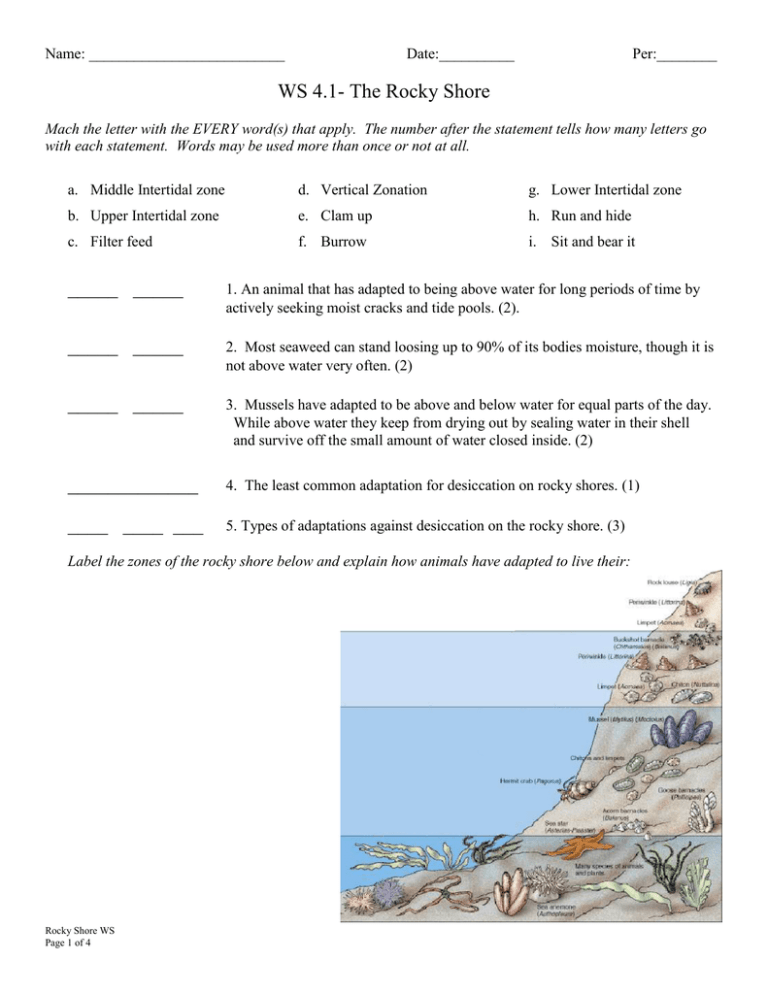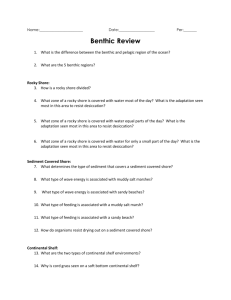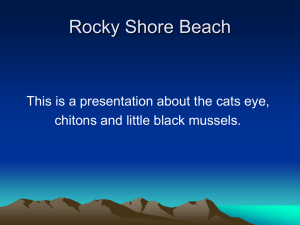Rocky Shore Ecosystem Worksheet: Adaptations & Zonation
advertisement

Name: __________________________ Date:__________ Per:________ WS 4.1- The Rocky Shore Mach the letter with the EVERY word(s) that apply. The number after the statement tells how many letters go with each statement. Words may be used more than once or not at all. a. Middle Intertidal zone d. Vertical Zonation g. Lower Intertidal zone b. Upper Intertidal zone e. Clam up h. Run and hide c. Filter feed f. Burrow i. Sit and bear it _____ _____ 1. An animal that has adapted to being above water for long periods of time by actively seeking moist cracks and tide pools. (2). _____ _____ 2. Most seaweed can stand loosing up to 90% of its bodies moisture, though it is not above water very often. (2) _____ _____ 3. Mussels have adapted to be above and below water for equal parts of the day. While above water they keep from drying out by sealing water in their shell and survive off the small amount of water closed inside. (2) _____________ 4. The least common adaptation for desiccation on rocky shores. (1) ____ ____ ___ 5. Types of adaptations against desiccation on the rocky shore. (3) Label the zones of the rocky shore below and explain how animals have adapted to live their: Rocky Shore WS Page 1 of 4 Read the passage and answer the questions: The Common Periwinkle The common periwinkle, winkle, or Littorina littorea, is a small edible species marine snail with gills. The shells range from ½ to 1 inch. Common periwinkles are native to rocky shores on the northeastern Atlantic Ocean along the coasts of northern Spain, Ireland, Scandinavia and Russia. The common periwinkle is primarily an algae grazer, but will feed on small invertebrates such as barnacle larvae. It has a suction cup like foot which allows it to cling to the feeding surface and resist getting washed away. The common periwinkle has numerous Adaptations that help it keep from drying out. The primary way the periwinkle keeps from drying out is by sealing water in it’s thick shell. Also the periwinkle’s are known for seeking small moist crevices for shelter to reduce the drying effects of the wind and sun. Finally the common periwinkle has the ability to lower metabolic rates during exposed periods to minimize oxygen consumption. Questions: 10. What zone of a rocky shore do you think it lives in? 11. Why do you think that organism lives in that zone of a rocky shore? 12. What adaptations against desiccation allow the common periwinkle to thrive in this region and zone? (use the vocabulary in your notes to answer this question) Rocky Shore WS Page 2 of 4 Mussels The common name mussel is used for members of several families of clams or bivalve mollusks (invertebrates that live inside 2 hinged valves or shells), from saltwater and freshwater habitats. In most marine mussels the shell is longer than it is wide. The external color of the shell is often dark blue, blackish, or brown, while the interior is silvery. The mussel's external shell is composed of two hinged halves or "valves". The valves are joined together on the outside by a ligament, and are closed when necessary by strong internal muscles. Mussel shells carry out a variety of functions, including support for soft tissues, protection from predators and protection against desiccation by sealing water inside its shell at low tide. The foot or soft body of the muscle has the ability to excrete a viscous secretion that hardens when it comes in contact with sea water. This forms extremely tough, strong, elastic, byssus threads that secure the mussel to its substrate. The adhesive protein excreted by mussels is unique to many manmade adhesives because it is not only stronger and more flexible, but it contains no toxic chemicals and it can harden and stick underwater. It is the strength that this adhesive allows mussels to stick to surrounding rock that gives them their name “Mussels.” After years of studying the chemical structure of mussel glue, scientists have succeeded in creating an adhesive that mimics it. Based on soy protein, the new adhesive is not only strong and non-toxic but will set underwater. It is already being used commercially in an environmentally-friendly brand of furniture. The manufacturers claim that because their furniture does not use formaldehyde-based glue (unlike most wood panels) it reduces indoor air pollution. The starfish, also called a sea star, feeds extensively on mussels. To eat a mussel, the starfish positions itself over the mussel, wraps its strong arms around the mussel’s two shells and slowly pulls them apart. After successfully creating a crack between the mussel shells, the starfish turns its stomach inside out, and inserts it through the gap it has created between the shells of the mussel. The stomach secretes digestive enzymes which dissolve the soft mussel body, and the stomach then reabsorbs the digested mussel as food. Thus, the starfish actually digests its food outside its body (called extracorporeal digestion), and the mussel is eaten alive while still in its shell. This predation is so intense that it single handedly keeps mussel populations in check. In areas where sea stars are removed mussels quickly take over and exclude every other organism in that area. Questions: 10. What zone of a rocky shore do you think mussels typically live in? 11. Why do you think that organism lives in that zone of a rocky shore? 12. What adaptations against desiccation allow muscles to thrive in this region and zone? (use the vocabulary in your notes to answer this question) 13. Why has a muscle adapted to “cling” to a surface and not burrow like its close relative the clam? 14. Predict what will happen when the starfish are removed from the shoreline as follows: Rocky Shore WS Page 3 of 4 Irish Moss Irish moss is a bushy seaweed that saved thousands of starving Irish during the potato famine of the mid 19th century. Irish moss is a relatively small photosynthetic red alga little more than 20 cm long. As with most species of algae it clings to the surface of its sub straight with a root like holdfast. From the holdfast Irish moss branches four or five times in a fan-like manner from the flexible steam like thallis. Irish Moss is traditionally given as a nourishing food for invalids and is still used to boost the body when recovering from a serious illness, due to its high content of important nutrients (it said to contain 15 of the 18 elements composing the human body). It has also been used to treat bronchitis, goiter, thyroid problems, and to tone and strengthen the body's glands. People have also used it as a laxative and a home remedy for sore throats and chapped skin. Other healing properties of Irish Moss include mild anticoagulant effect on the blood; treats chronic lung diseases, dysentery, diarrhea and disorders of kidney and bladder. Experimental results have shown that Irish Moss may also reduce high blood pressure. It is also said to reduce gastric secretions and has been used in absorbent surgical dressings. During low tide Irish moss is extremely resistant to death by desiccation. It can survive even after loosing the majority of its water and quickly becomes rehydrated when the tide come back in. Questions: 10. What zone of a rocky shore do you think Irish moss typically lives in? 11. Why do you think that organism lives in that zone of a rocky shore? 12. What adaptations against desiccation allow Irish moss to thrive in this region and zone? (use the vocabulary in your notes to answer this question) Rocky Shore WS Page 4 of 4




